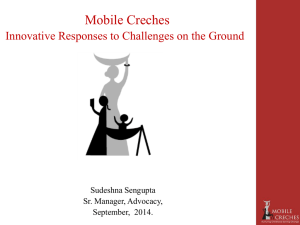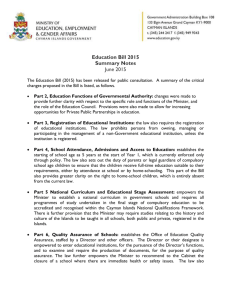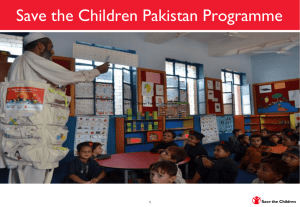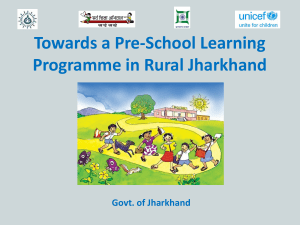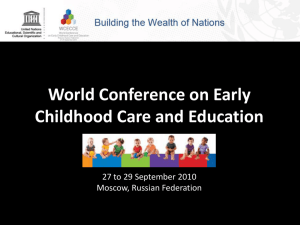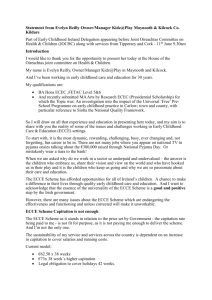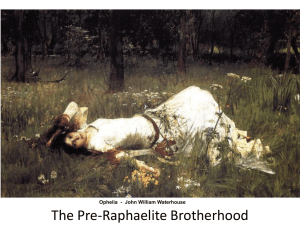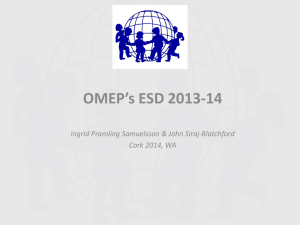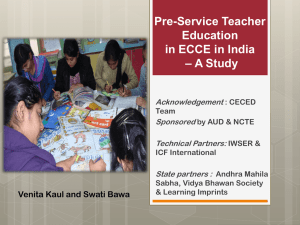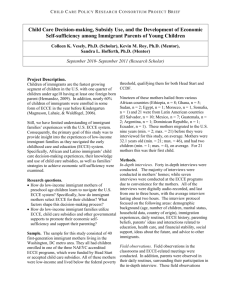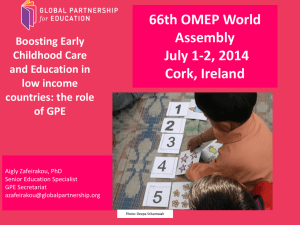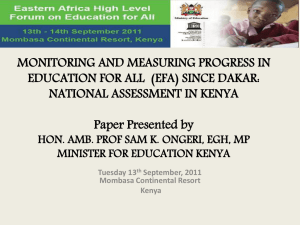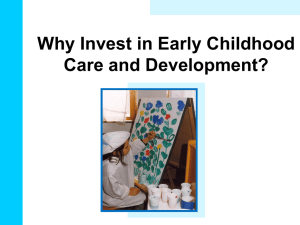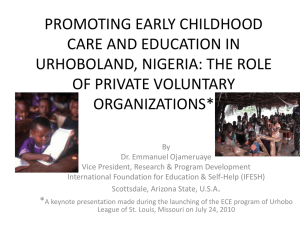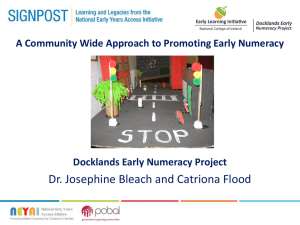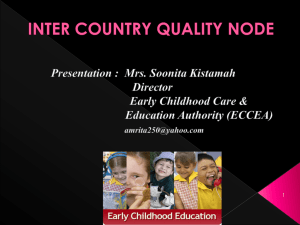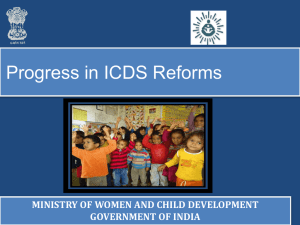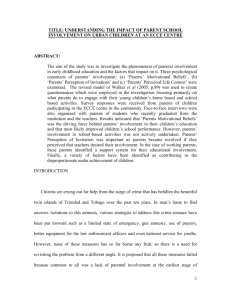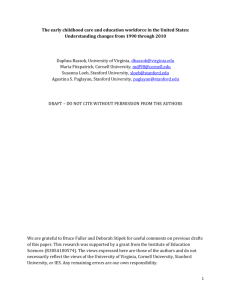caroline_Arnold_presentation_SA_Conferemce
advertisement
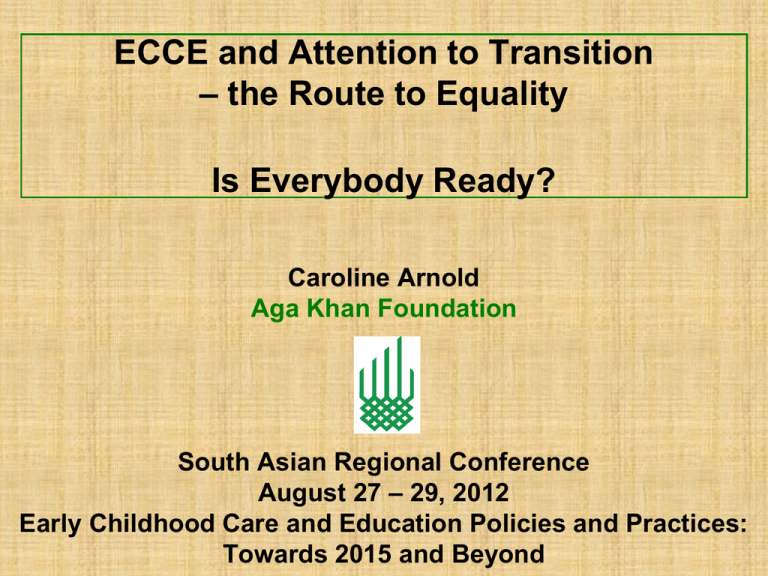
ECCE and Attention to Transition – the Route to Equality Is Everybody Ready? Caroline Arnold Aga Khan Foundation South Asian Regional Conference August 27 – 29, 2012 Early Childhood Care and Education Policies and Practices: Towards 2015 and Beyond ECD Significant and sustained benefits Key to addressing deep-rooted patterns of discrimination and exclusion Studies – India, Nepal, Bangladesh, Pakistan, Turkey,Egypt, Jamaica, Guinea, South Africa, US, UK, Peru Most dramatic gains for disadvantaged Nepal Initial Enrollment into Grade 1 ECD All children > 95% 75% (district) Promotion from Grade 1 to 2 ECD Non-ECD 84% 42% Double Results most dramatic for dalit children and girls India Retention rate in primary National level ICDS evaluation (25 states) ECD No ECD 89% 68% Chaturvedi Study No impact on drop-out for high caste children but 46% reduction for lowest castes Gender Equity • Brazil Girls from low-income families who attend preschool 2 X as likely to reach Grade 5 3 X as likely to reach Grade 8 • Nepal: Boy/ Girl ratios Grade 1: Grade 2: ECCE 50/50 Non-ECCE 61/39 ECCE 54/46 Non-ECCE 66/34 Pakistan RCC Key Findings (Transition Project) Learning Achievement Test scores, Class 1 100% 80% 65% 50% 68% 68% 55% Project 50% Non-Project 0% English Urdu Math Benefits most pronounced for girls and government schools serving the most disadvantaged 05-134 GDP & Grade 3 Language Scores Language Score Country GDP $ Chile 9.930 351 Mexico 6.769 247 Colombia 6.347 242 Brazil 5.928 240 Cuba 3.100 236 UNESCO 1998 BUT Early Childhood Care and Education AND Early Primary is when Education Systems fail children (especially marginalized children) the worst Lack of ECCE Access • Sub- Saharan Africa : 86% - NO access • South & West Asia : 58% - NO access For the vast majority of disadvantaged children transition is still from home to school Failure to provide adequate financial resources (national governments and international donors) Disparities within countries • Globally - failure to reach most disadvantaged (social, economic, geography, parental ed.) EFA Goal 1 • Syria, Mongolia, Kyrgyzstan: Children from wealthiest 20% > 5 X as likely to attend pre-school as those from poorest 20% • Bangladesh Wealthiest 20% >2X as to have learning opportunities at home Have we done enough to make sure policy-makers understand the connection between EFA’s 1st goal and the attainment of other EFA goals and MDGs? • Access and Completion of basic education (goal 2) • Gender Equity (goal 5) • Quality (goal 6) Attention Increasing – but slowly • More data, better analysis • Evidence of benefits of ECCE • Devastating consequences of combination of i)lack of supports for early childhood ii)lack of attention to early primary Children not ready for Schools and Schools not ready for Children Limited Progress towards EFA goals • Massive increases in initial enrolments BUT – Inadequate increases in completion in too many places – Poor learning achievement (ASER) Where are Efforts breaking down? Right at the beginning SCHOOL The Crisis in Grade 1 Grade 1 DROP-OUT* Pakistan 16% India 15% (>3 X Grade 4 drop-out) Grade 1 REPETITION Nepal 30% Bihar,India 16% (MIS,SSA) * Source: EFA GMR /11 Even if stay in school….millions become set in persistent patterns of under-achievement Early primary years - Key to systemic failures in education COSTLY IN BOTH HUMAN AND FINANCIAL TERMS 3 Questions and Challenges: 1) Why do ECCE professionals and policy-makers ignore the 6-8 year-olds when ECCE is defined as covering 0-8? 2) Why are large scale education reform efforts not giving focused attention to early primary? 3) How can we conceptualize and implement work so that ECCE and early primary part of a whole? Increase resources for and ensure access to ECCE programmes – ECCE for all and ESPECIALLY the marginalized. Target – Flexible approaches that enable reach to remote areas and excluded groups – Minimum targets for ECCE budgets (wellbalanced systems invest about 10% of education budget in ECCE) – Quality – Links between ECD and primary Increase resources for early primary as critical to education reform addressing the equity and learning crisis – Invest the best in early primary (opposite of present) • Experienced, capable teachers in lower primary; improved knowledge, skills and status – Focused attention to lower primary in training – Welcoming, appreciative, inclusive, safe, healthy environment for children and parents – Focus on LEARNING – esp. language & literacy – systematic teaching of reading – Mother tongue - transition into additional language/s – Learning materials in children’s hands GENERATE AND USE EVIDENCE TO MOBILIZE POLITICAL AND POPULAR SUPPORT • Data demonstrating solid results from ECD and early primary work vital – Building commitment – Influencing Policy – Mobilizing Resources • Decision-makers need local evidence – Impact on education indicators – Fit with priorities and commitments of target group GENERATE AND USE LOCAL EVIDENCE Afghan Badakshan: 2005: half as many girls in Grd.6 as in Grd.1 ECCE & Focussed attention to early primary introduced 2011: 17% fewer girls in Grd.6 as in Grd.1 Attention to ECCE including early primary Key to Countering discrimination and Ensuring a good start for ALL CHILDREN Thank you Aga Khan Development Network www.akdn.org
